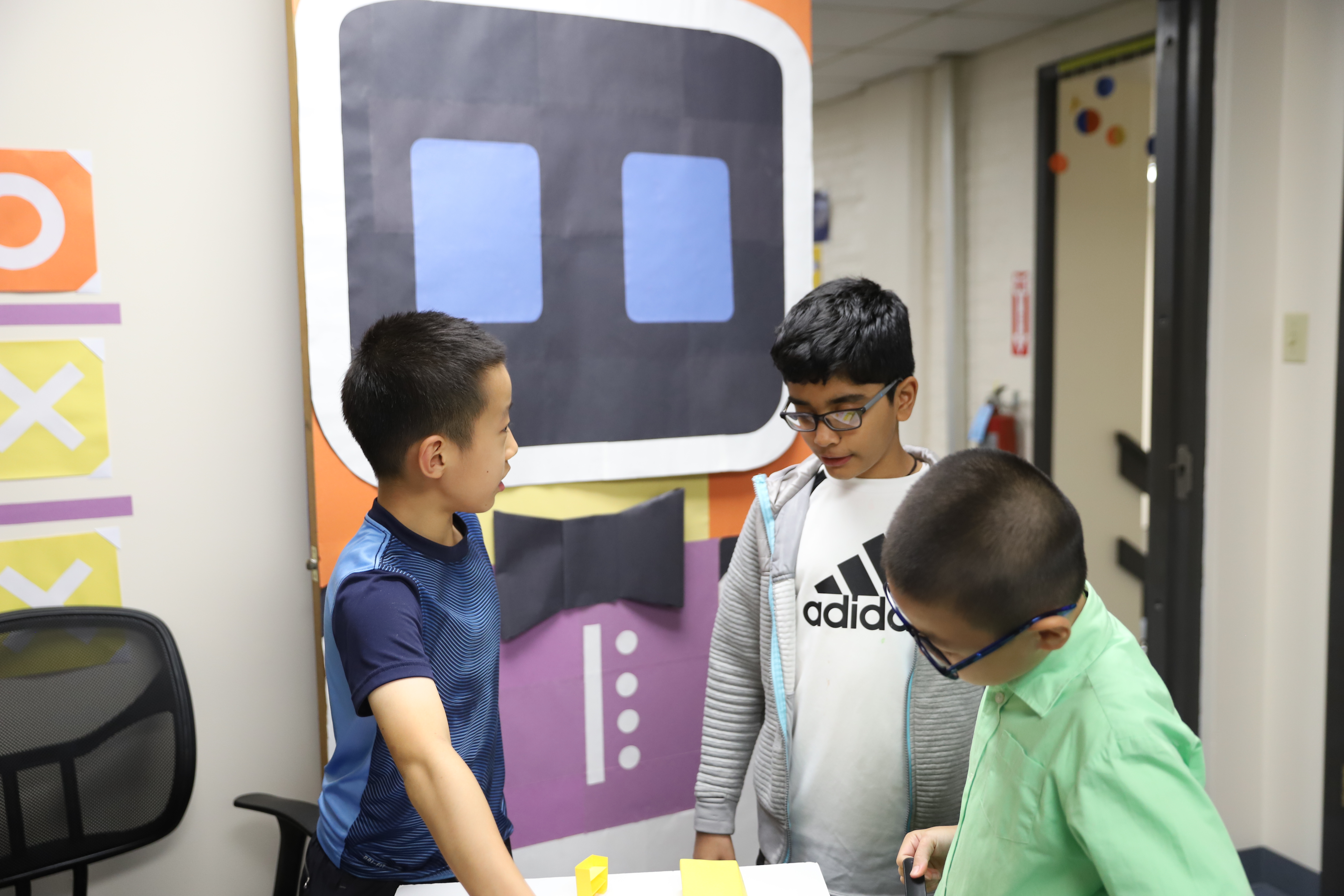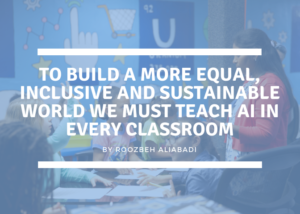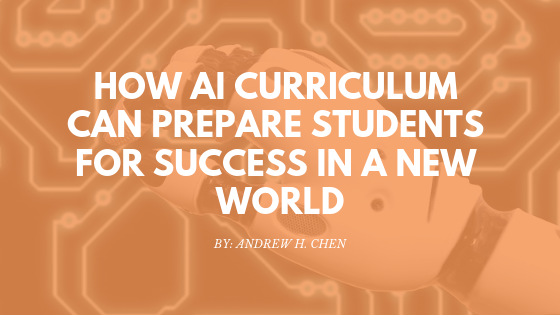
We Must Become the Kid
to Teach the Kids
Too many parents sign up their kids for some fancy summer course in Artificial Intelligence. Too often too many parents, students and even teachers have no idea what Artificial Intelligence is except for robots or something like people at CMU or Silicon Vally think everything will have AI someday in the future, so we better start to learn it now.
Teaching Artificial Intelligence could be viewed as complex but we think there are two important concepts that we would lie to introduce to young students: Curiosity and Courage.
There are many ways to do this but let’s start with these:
- Let’s use Motivations from History: The BIG WHY. It is important to the students’ historical context and motivation for the technology they use every day, making sure they understand that before – Cozmo, kindle and other devices existed, they were just a crazy idea someone dreamed up.
- How about Productive Curiosity: The BIG WHAT. It is important that we give students permission and encouragement towards asking the right questions of Why + What + How. This is a great opportunity to lead the students by demonstrating what the right kind of question feel like by tying it to stories and concepts they are familiar with.
- We should talk about Ideas worth Realizing: The Big HOW. It is important to show the students in what ways they could dram while emphasizing that if it really was obvious and easy, someone has done it by now already.
Motivations: Why don’t we start with the very very very basics. Why do computers even exist? Well, students typically will say that computers exist because we are lazy and bored, they have a point :) We can take the conversation and talk how money and curiosity also motivate invention and eventually arriving at an ultimate motivation to survive as a human race. It is amazing how many students haven’t been invited to ask WHY and HOW these everyday devices even exist.
So one way to show a dramatization of the historical motivation of technology, we can start with the trailer of the movie Imitation Game. (If you have not seen the movie, definitely watch it. It’s really amazing. The Imitation Game is a 2014 American historical drama thriller film loosely based on the biography Alan Turing: The Enigma by Andrew Hodges (which was previously adapted as the stage play and BBC drama Breaking the Code). It stars Benedict Cumberbatch as real-life British cryptanalyst Alan Turing, who decrypted German intelligence codes for the British government during the Second World War.)
Why don’t we ask the following question after playing the trailer of Imitation Game?
- Why did they want better machines?
- Before we had the technology to do these types of tasks for us, how were these tasks done?
- How do we imagine and build something that ’ event exist yet?
Why do we want kids to watch a movie about WWII. Well, it helps students to understand HOW developers, creators, and inventors were once just kids like they are. We want them to imagine themselves in the shoes of these individuals. Like Alan Turning in The Imitation Game.
Curiosity: Let’s move forward to the bread and butter. We can ask a very simple question. What is Artificial Intelligence? After all, this is why we started ReadyAI. And we are trying to teach them AI. Well if students learn anything at all, let’s make it clear that after this first lesson they should at least be able to CONFIDENTLY answer if someone asked, “What is Artificial Intelligence?”
Typically students, parents and frankly many others give a typical answer which is usually along the lines of “Robots and stuff”. Maybe it is sometimes easier to understand a concept by thinking and imagining the things that aren’t rather than things that are. We can do so by intentionally leading them to answer the following questions.
- Does a rock have AI?
- Does your pencil have AI?
- Does the whiteboard have AI?
- Do dogs or cats have AI?
- Does a human (we can make it relevant to use the teacher or a student or the principal of the school – and add humor) have AI?
“Does your gym teacher have Artificial Intelligence?” Students seem to think this is funny no matter what. And to add more humor we can say “your teacher can be a robot that recharges through power cables instead of sleeping.”
We think it is important for students to build the habit of asking questions like what is “artificial and what is “intelligence.” We can perhaps do the same exercise by asking two separate questions of:
- What is artificial?
- What is intelligence?
So, what is AI? A typical answer is along the lines of “computer that think” or “Smart machines or robots,” which are pretty decent answers. It is actually easy to explain what ameks something artificial (human-made things, like computers, robots, Pizza (not Pizza, we are joking of course)) But we think asking “what is intelligence?” will be much better classroom discussion.
It is not that hard to get the thinking in the right direction. We can ask a series of questions like:
- What about Artificial flight or flying?
- What is that???
- Do birds have artificial flight?
- Why Not?
- If we throw a paper ball, is that flying?
- What if it’s a paper airplane?
- How did we even know flying was a thing?
- How did we finally even invited Artificial Flight?
*By the way, there is a fantastic essay called – What inspired us to fly? It is a must read.
Ok now, how we have asked about the flight, where do we get inspiration for intelligence? It’s important for students to ask themselves:
What does it mean to be human?
Because, ultimately, if we can tell them what we mean by intelligence and give them a design for building it, we have a pretty solid and actionable understanding of AI.
Now, Why don’t we watch this movie together?
A.I. Artificial Intelligence (also known simply as A.I.) is a 2001 American science fiction drama film directed by Steven Spielberg. Set in a futuristic post-climate change society, A.I. tells the story of David (Osment), a childlike android uniquely programmed with the ability to love.
Ideas: Let’s ask another important question. How can we build better machines?
Why don’t we do a simple exercise with the students?
We can ask students to get out their pencil and paper for a very simple exercise. We can tell them, in column A, we want all the ways that computers are better than humans. In column B, we want all the way that humans are better than computers. Five minutes seem to be a good amount of time for them to write down their thoughts.
The answer could look like this:
- Computers: faster, better at math, good at repetition, don’t need to sleep or eat, very good at searching and really good at remembering things.
- Humans: much better than emotions, creating things, being original, improvising, eating, pooping :)
We can also derive them to things like humans are very good at seeing, hearing, smelling, tasting and touching. Once we have discussed the specifics of human movement, language, and learning, we are able to make connections from the named human attributes to common and novel pursuits in AI: Here are a few examples:
- Believable AI + Expressive AI
- Computational Creativity
- Procedural Content Generation
- Computer Vision
- Robotics
- Natural Language Generation and Understanding
- Machine Learning
Ok before we get fancy with these topics, let’s go back to the basics.
Let’s go back to our simple exercise. Before machines, everything in column A was actually under column B. As we – the people – much like the students in our classrooms, ask themselves these types of questions, we began to devleop a deeper understanding of why machines should be better, what they can be better at, and how they can be better.
Let’s move the fun part. Let’s watch some Youtube videos for the rest of this first session. Kids will love it. Because it turns out that kids, across the world, love watching YouTube videos. For countries that internet is difficult to access and YouTube is not available – Don’t worry, we have downloaded these videos for you.
- LEGO Sudoku Bot: Are computers or humans better at Sudoku?
- Pancake Bot: Are computers better at making pancakes?
- Robot Dog: Are computers better at moving about?
- Robot Arm: Better at catching something?
- Google Self-Driving Cars: And what about driving?
Now that we have the students excited, let’s take our iPhone out of our pocket and say. “Hey Siri, Am I a good teacher? Or do I put my students to sleep?” This is a good time for the trailer of one of the more recent movies that are out there. Her is a romantic science-fiction drama film that explains how we can take an existing technology to really project future scenarios. The moviemaker and engineers aks themselves how computers and machines boudl be better, and when they watch, read or hear bits of fiction, students can be both critical of and inspired by it.
Oh, before I forget, there is another one, It’s called Kara, which is a visually stunning and emotional PS3 technology which is here “represented by a female android who becomes self-conscious. CRAZY, RIGHT?
OK, LET’S NOT GET AHEAD OF OURSELVES AND COME BACK TO EARTH.
We can also go on something that is less fictional.
- Project Natal Milo Demo: Is this one real or not?
- Cleverbot vs Cleverbot: Maybe reality looks more like this?
- Facade: Then there’s my Ph.D. advisor’s work, Facade.
Let’s get a bit funny here. In the end, education will be effective if we have fun.
Let’s watch a funny video:
This is not only a funny video but also effective.
So if you have noticed, in the first very session we don’t even actually tell them what AI. It is about showing them a bunch of videos and really leading them through discussion on how the actually like to connect those dots. Because how we define AI is only as meaningful as the community we find ourselves in, and even then, it actually changes very frequently.
Let’s keep in mind AI learning and teaching are more about encouraging our student to have and keep their lifelong curiosity on what it means to be human, and how we can be better at that.
Let’s start this together.
ReadyAI




Leave A Comment
You must be logged in to post a comment.